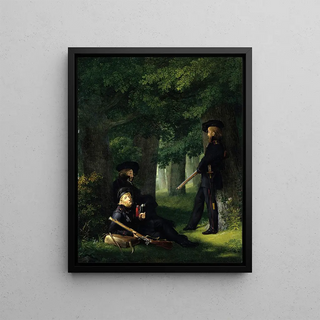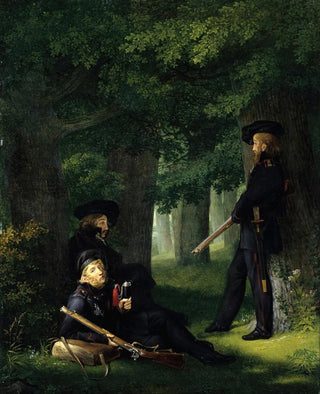Art print | At the outpost - Georg Friedrich Kersting


View from behind

Frame (optional)
Georg Friedrich Kersting's art print "At the Outpost" presents itself as an open window into a bygone era, a visual testament to the artistic sensitivity of the early 19th century. This painting, imbued with realism and delicacy, invites the viewer to immerse themselves in a frozen moment, where every detail is carefully orchestrated to evoke an atmosphere of contemplation. Upon discovering it, one feels a deep connection with the depicted characters, as if they are telling their story through the silence of their expressions. The soft light illuminating the scene helps create an intimate ambiance, making this art print particularly captivating for anyone interested in art history.
Style and uniqueness of the art print
Kersting, a master of German Romantic painting, manages to fuse realism and poetry in "At the Outpost." The composition of the work is meticulously thought out; the characters seem to be in deep reflection, each absorbed in their thoughts, which creates a silent dialogue between them and the viewer. The color palette, dominated by soft and natural tones, enhances the impression of serenity and intimacy. The details of clothing, facial expressions, and surrounding objects testify to a concern for realism that characterizes Kersting's style. This art print is not merely a depiction of human figures but an exploration of emotions and states of mind, making it a singular work within the artistic landscape of its time.
The artist and his influence
Georg Friedrich Kersting is an emblematic figure of German Romanticism, whose work was influenced by pioneers such as Caspar David Friedrich. Although less well-known than some of his contemporaries, Kersting managed to forge a distinct artistic identity through his unique approach to light and composition. His work has been praised for its ability to capture the psychology of characters, a quality that is reflected in "At the Outpost." Kersting's influence is felt not only among his contemporaries but also in subsequent generations of artists, who have been inspired by his way of addressing themes of introspection and solitude. Through his art print,

Matte finish

View from behind

Frame (optional)
Georg Friedrich Kersting's art print "At the Outpost" presents itself as an open window into a bygone era, a visual testament to the artistic sensitivity of the early 19th century. This painting, imbued with realism and delicacy, invites the viewer to immerse themselves in a frozen moment, where every detail is carefully orchestrated to evoke an atmosphere of contemplation. Upon discovering it, one feels a deep connection with the depicted characters, as if they are telling their story through the silence of their expressions. The soft light illuminating the scene helps create an intimate ambiance, making this art print particularly captivating for anyone interested in art history.
Style and uniqueness of the art print
Kersting, a master of German Romantic painting, manages to fuse realism and poetry in "At the Outpost." The composition of the work is meticulously thought out; the characters seem to be in deep reflection, each absorbed in their thoughts, which creates a silent dialogue between them and the viewer. The color palette, dominated by soft and natural tones, enhances the impression of serenity and intimacy. The details of clothing, facial expressions, and surrounding objects testify to a concern for realism that characterizes Kersting's style. This art print is not merely a depiction of human figures but an exploration of emotions and states of mind, making it a singular work within the artistic landscape of its time.
The artist and his influence
Georg Friedrich Kersting is an emblematic figure of German Romanticism, whose work was influenced by pioneers such as Caspar David Friedrich. Although less well-known than some of his contemporaries, Kersting managed to forge a distinct artistic identity through his unique approach to light and composition. His work has been praised for its ability to capture the psychology of characters, a quality that is reflected in "At the Outpost." Kersting's influence is felt not only among his contemporaries but also in subsequent generations of artists, who have been inspired by his way of addressing themes of introspection and solitude. Through his art print,






